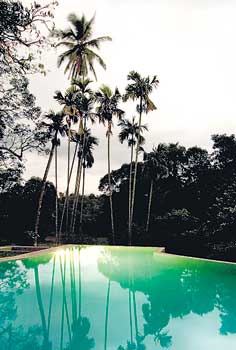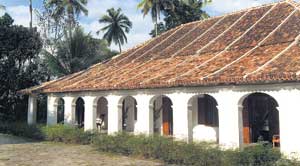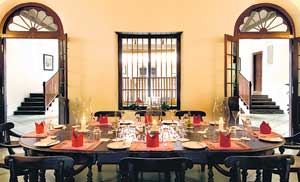
A house you wish was yours“Is this Kandy House?” I asked in bewilderment after a bone-shaking drive around the outskirts of Kandy. I was puzzled because, as the gate marked by elegant stone posts was opened, I saw a group of boys wearing saffron shorts playing cricket on the lawn in front of a squat, clay-tiled walauwa. I thought I had arrived at a seminary not a hotel.
Despite being assured by the gateman that I was indeed at Kandy House, I asked again at the entrance veranda as a boy, looking like the head prefect, came to greet me. The cricket players scattered and only when I saw the hotel’s attractive logo of arches on the lad’s T-shirt was I convinced. Such was my introduction to yet another of Sri Lanka’s amazing and unusual places to stay. The unorthodox welcome turned out to be typical of the easy-going, homely style of Kandy House. It was originally built in 1804 as the home of the last chief minister to the last king of Kandy. Two hundred years later it was transformed into a special place for paying guests, by architect Channa Daswatte, with a flourish of polished titanium cement floors combined dramatically with ancient wooden boards. Its nine suites have bathrooms of solid cement softened by the warmth of traditional timber fittings. There are two bedrooms off the entrance veranda and these both have their own dining tables around the corners on the long side verandas. The verandas are deep with low eaves and stout columns while the front veranda is defined by seven arches, hence the hotel’s logo. It is a fine place for watching the staff practising cricket, which they do occasionally in the afternoons, or for sipping tea in the warmth of the morning sun. There are nearly 20 staff employed to look after guests so attention to one’s demands is always alert. My first demand was to ask if there was a swimming pool. After the tortuous drive, I needed to calm my nerves. I was directed out of the house, across a lawn and then down some steps to an enticingly lush garden where an infinity pool edges towards the green of an adjoining paddy field below. Huge trees lend shade, enabling guests to relax and read by the pool in bliss-inducing tranquillity. The interior of Kandy House has been cunningly designed to create corners of seclusion. The entrance hall with a gigantic floral arrangement gives way to a formal dining saloon. This opens onto a courtyard with cloisters downstairs and a wooden gallery fronting the bedrooms above. At the far end of the cloisters there is a lounge, called the Butterfly Bar, for discreet conversation over cocktails. The rooms are all named after butterflies with the largest, the Black Rajah suite, featuring an octagonal two-person bath tub in its centre. The rooms have wooden doors and window shutters open to the breeze (there is no AC here, just whirring fans) in keeping with the relaxed mood of the place. And there are no telephones or televisions in the rooms either.
Lunch and dinner is by set menu with the cuisine described as ‘Pacific Rim and Sri Lankan’ of the finest ingredients and no red meat. Meals can be served where guests want, either on their verandas, in the main saloon, or on the garden veranda at the back of the house. That small garden has been enlivened with the brilliant addition of huge framed mirrors on its surrounding walls. This gives it a magical depth as well as a chance for guests to take a sly admiring glance at themselves. That’s appropriate, as Kandy House is the place for the discerning and successful who want to withdraw from pressures for a few days and enjoy the rewards they feel they deserve. Kandy House is neither easy to find nor cheap to stay at. Tania Brassey, the gracious and charming manager, is happy to provide directions. The uniformed staff members (saffron shorts in the day time, saffron sarongs in the evening) are there to give personalised service to match the grandeur of the place. Saffron is the key colour with the brochures, the registration card (which asks guests not to smoke in the house) and the bill, all in that inspiring orange-yellow. It’s a distinctive colour that reflects the serenity of the setting, making guests reluctant to leave what they have surely been tempted to pretend is their own house in Kandy. (Amunugama Walauwa, Gunnepana; www.thekandyhouse.com) |
|
||||||
|| Front
Page | News | Editorial | Columns | Sports | Plus | Financial
Times | International | Mirror | TV
Times | Funday
Times || |
| |
Reproduction of articles permitted when used without any alterations to contents and a link to the source page.
|
© Copyright
2008 | Wijeya
Newspapers Ltd.Colombo. Sri Lanka. All Rights Reserved. |


